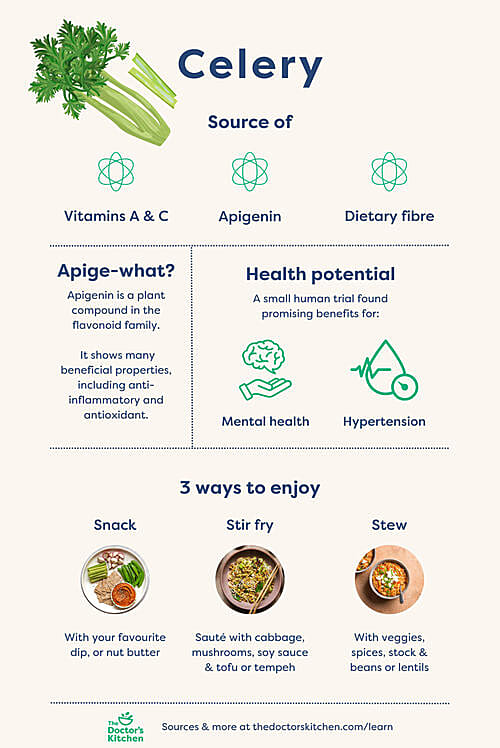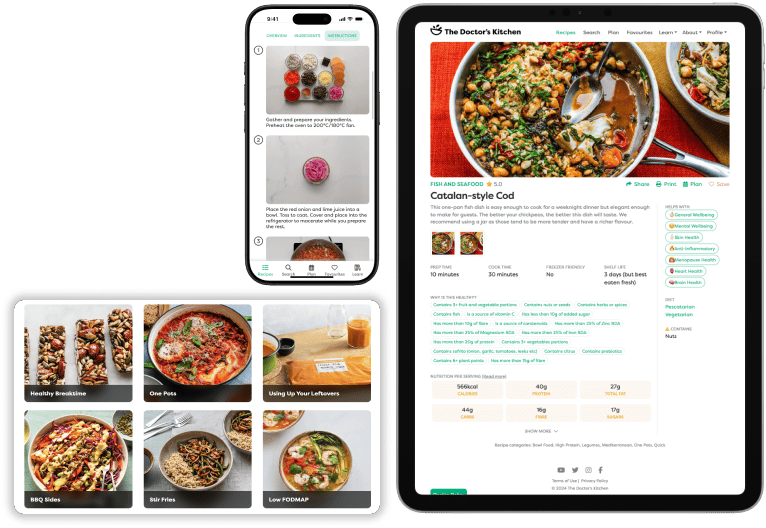Celery: A source of apigenin
15th Sep 2023
Celery is an unsung backstage hero that we think deserves more appreciation. Not only is it essential to the flavour of many dishes, but it also provides nutrients and beneficial plant compounds.
Key points
In a Nutshell

Plant Tales
Before it was a vegetable, it was an herb: Celery is native to the Middle East and the Mediterranean areas. The ancient forms resembled smallage - a leafy herb of the Apiaceae family alongside parsley, dill and coriander. Celery with stalks was developed in the late 18th century.
Traditional uses: In traditional medicine systems, the root, leaf and seed are used in various preparations for regulating digestion, calming the nerves and treating urinary and kidney problems.
Is celery celeriac? They are actually the same plant: Apium graveolens. Celeriac is a type of celery cultivated for its fleshy bulb rather than for its stalks. There is also a leaf celery that produces an abundance of leaves.
Seed to plant: To grow, celery needs high levels of moisture and lower temperature. It’s ready to harvest from midsummer to autumn before the first hard frost. Now is the time to buy fresh-picked celery from a farmer’s market or local veg box.
Research Digest
Celery’s Health Potential: To date, small human studies found promising benefits for:
- Anxiety and depression: A randomised controlled trial found that celery seed extract improved symptoms of anxiety and depression in 50 hypertensive patients.
- Hypertension: In the same trial, celery consumption also reduced blood pressure parameters.
- Type 2 diabetes: A small study found that celery leaf extract reduced blood glucose levels before and after a meal in prediabetic adults.
Being such a commonly consumed vegetable, human studies are surprisingly sparse. Undoubtedly, there is a need for more research investigating the health benefits of celery.
Celery’s Beneficial Compounds: To your plate, it adds:
- Vitamins A and C
- Dietary fibre
- Flavonoids, particularly apigenin, kaempferol and luteolin
- Phenolic acids, such as caffeic and ferulic acids
Apige-what? Apigenin is a flavone - a subclass of flavonoids - primarily found in plants. It appears to suppress proinflammatory cytokines and slow glucose absorption in preclinical studies. Luteolin is another flavone with promising benefits in pain management.
Why does it taste like that? The aroma profile of celery is created by an assortment of compounds, such as terpenes and phthalides.
In daily life: One portion is 1 celery stick. Cooking inspiration heading your way…
Tasty Tips
Around the world
Celery often forms the foundational flavour trio in various culinary traditions. In France, it’s the mirepoix, in Italy, the soffritto, and in Louisiana, the Holy Trinity, where it joins forces with onions and carrots or peppers.
- New York: The Waldorf Salad with celery as a key ingredient that nicely contrasts with the sweetness from the fruit and the creamy dressing.
- France: Celery remoulade - a classic salad that combines crispy grated celery root with a light mayonnaise.
- India: Pickled celery, flavoured with spices like mustard seeds and fenugreek.
5 ways to enjoy celery
- Snack: Slice into batons and pair it with your favourite dip, or try the classic “Ants on a Log“ by spreading it with nut butter.
- Soup: Sauté with seasoning and veggies like onions, carrots, and potatoes. Add stock, and herbs, simmer until soft and blend if you like.
- Stir fry: Sauté with sesame oil, spring onions, garlic, ginger and tofu in sauce.
- Bean stew: Sauté with olive oil, spices and other veggies. Add white beans and vegetable stock. Simmer until soft and serve with fresh herbs and olive oil.
- Salad: Mix with green onions, cooked lentils, chopped dates, nuts and serve with a lemon vinaigrette. Or try this celery-forward salad by a real celery enthusiast!
Pair it: Celery goes well with apple, walnut, peanut, carrot and contrasting ingredients like blue cheese.
Don’t throw away the leaves : Use them like herbs in a pesto instead of basil, in salads or as a garnish. A great way to use up what you have in the fridge.
Recipes to try:
- Beetroot, Apple and Ginger Soup
- Aubergine & Walnut Ragu
- Smashed Chickpea Sandwich (free in the app)
- Shiitake Mushroom, Celery and Cabbage Stir Fry with Konjac Noodles (App)
Sources
History, compounds & biological activities: Turner et al. Food Chemistry. 2021 - Li et al. Horticulture research. 2022 - Li et al. Horticulture research. 2020
Human health: Shayani et al. Inflammopharmacology. 2023 - Yusni et al. Saudi Med J. 2018
- Access over 800 research backed recipes
- Personalise food for your unique health needs
